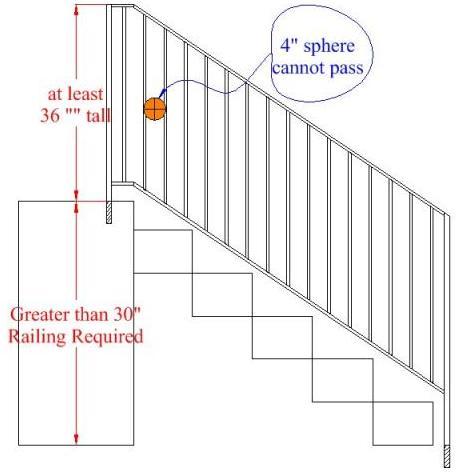Safe Steps: Mastering Residential Stair Railing Code

Ever tripped on the stairs? It's a scary thought, and a very real danger in homes without proper railings. That’s why understanding residential stair railing code requirements is crucial for every homeowner. These regulations aren’t just bureaucratic red tape; they're designed to prevent accidents and ensure the safety of your family and guests.
Navigating these building codes can feel overwhelming, but it doesn't have to be. This guide will break down the essential aspects of stair railing regulations, helping you understand why they're important and how to ensure your home complies. We’ll explore everything from height requirements and spacing guidelines to the specific materials allowed.
Historically, building codes, including those for stair railings, emerged from a need to protect public safety. Early codes were often reactive, implemented after tragic events highlighted the need for standardized safety measures. Over time, these codes evolved, becoming more comprehensive and proactive in preventing accidents. Residential stair railing codes specifically address the unique risks associated with stairs in homes, recognizing that falls are a leading cause of injuries.
The core principle behind stair railing codes is to provide stable and secure support for anyone using the staircase. This means railings must be sturdy enough to withstand the weight of someone leaning or falling against them. Regulations also dictate the height of the railing, ensuring it provides adequate fall protection. Spacing between balusters is also carefully controlled to prevent small children from slipping through.
A key issue with residential stair railing code requirements is ensuring consistency and enforcement. Variations in local codes can sometimes create confusion, and homeowners may be unaware of the specific regulations that apply to their area. That’s why it’s vital to research your local building codes and consult with a qualified professional if you have any questions. Understanding and adhering to these codes isn’t just about avoiding penalties; it’s about creating a safe and secure home for everyone.
One crucial aspect of railing codes is the height requirement. Most codes specify a minimum height of 34-38 inches, measured vertically from the nosing of the stair tread to the top of the railing. This height provides adequate protection for adults and children alike. Another critical element is the spacing between balusters or spindles. This spacing should be no more than 4 inches to prevent small children from getting their heads or bodies stuck.
Three key benefits of adhering to residential stair railing codes are enhanced safety, increased home value, and peace of mind. Firstly, compliant railings drastically reduce the risk of falls, protecting your family and guests from potential injuries. Secondly, a safe and well-maintained home, evident in compliant features like stair railings, can boost your property’s value. Finally, knowing your home meets safety standards provides invaluable peace of mind.
Planning your stair railing project involves several steps. First, research your local building codes. Next, choose materials and a design that meets these requirements. Finally, hire a qualified contractor to install the railing, ensuring it adheres to all applicable regulations.
Advantages and Disadvantages of Adhering to Stair Railing Codes
| Advantages | Disadvantages |
|---|---|
| Increased Safety | Initial Cost |
| Higher Home Value | Design Limitations (in some cases) |
| Peace of Mind | Time Investment for Research and Installation |
Best Practices:
1. Consult Local Codes: Always check your specific local building codes for stair railings.
2. Hire a Professional: Engage a qualified contractor experienced in stair railing installation.
3. Use Durable Materials: Choose materials that are weather-resistant and can withstand wear and tear.
4. Regular Maintenance: Inspect and maintain your railings regularly to ensure they remain safe and secure.
5. Consider Accessibility: If you have elderly or disabled family members, consider additional accessibility features like handrails on both sides of the staircase.
FAQ:
1. What is the standard height for a stair railing? Generally, 34-38 inches.
2. Do I need a building permit for a new stair railing? Often, yes. Check your local regulations.
3. What materials are allowed for stair railings? Wood, metal, and composite materials are common.
4. How much does it cost to install a stair railing? Costs vary depending on materials, length, and complexity.
5. Can I install a stair railing myself? While possible, professional installation is recommended for safety.
6. What is the maximum spacing allowed between balusters? Typically 4 inches.
7. Are there specific code requirements for outdoor stair railings? Yes, often related to weather resistance.
8. Where can I find my local building codes? Contact your local building department or municipality.
Tips and Tricks: When planning your railing, consider the overall aesthetics of your home. Choose a design that complements your style while meeting code requirements. Also, remember that regular maintenance, such as tightening screws and repainting, can extend the life of your railing.
In conclusion, understanding and adhering to residential stair railing code requirements is paramount for ensuring the safety and well-being of everyone in your home. These regulations, developed over time and informed by experience, provide essential guidelines for creating a secure and accessible staircase. By following these standards, you not only protect your loved ones from potential harm but also enhance the value of your property and enjoy the peace of mind that comes with knowing your home meets essential safety standards. Take the time to research your local codes, consult with professionals, and prioritize safety in every step of your stair railing project. Don’t wait until an accident happens; take proactive steps today to create a safe and secure home for tomorrow. Building a safe environment begins with awareness and action, so invest in the safety and well-being of your home and family by ensuring your stair railings are compliant with all applicable codes. Your peace of mind and the safety of those you care about are worth the effort.
Fifa 23 nintendo switch price breakdown
Decoding the chevy silverado 2500 hds weight a comprehensive guide
Unleashing power exploring the new 65 turbo diesel engine











:max_bytes(150000):strip_icc()/stair-handrail-and-guard-code-1822015-final-CJ-01-157768d7ac40439da36f9ba69faa00c6.png)

